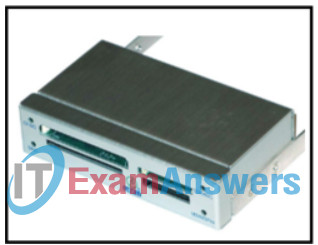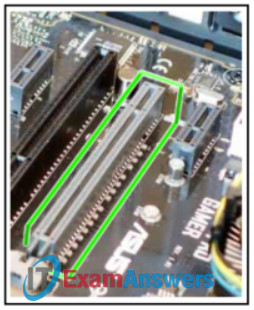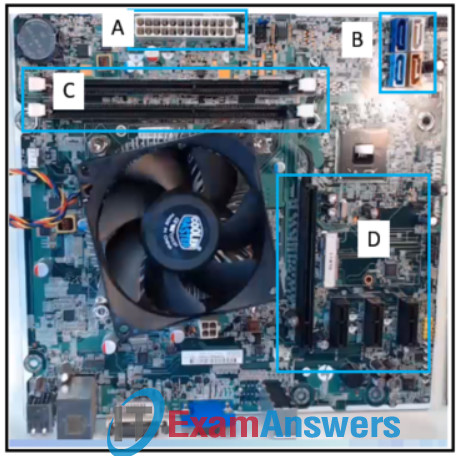IT Essentials ( Version 8.0) – IT Essentials 8.0 Chapter 2 exam answers
1. A technician is replacing a power supply. Which two factors should the technician consider when obtaining the replacement part? (Choose two.)
- input voltage level of 12 or 5 VDC
- wattage
- type of case
- number of internal fans
- output voltage
2. When a new PC is being built, which component has the most influence when selecting the case and power supply?
- hard disk type
- motherboard
- RAM module
- sound card
- video card
3. Refer to the exhibit. Which device is shown?

- SATA drive
- KVM switch
- media reader
- optical drive
4. What is a good safety precaution to take when opening a computer case?
- Place tape over the case edges that are sharp.
- Remove the connections to the front panel before extending the case fully open.
- Remove the cover (or door) of the computer case before installing or removing parts.
- Ensure that any loose clothing such as a tie or shirt stay in constant contact with the case when handling internal components.
5. A student is looking to add memory in order to speed up a tower computer. Which type of memory module should the student be looking for?
- DIMM
- DIP
- SIMM
- SODIMM
6. How is a power supply commonly attached to a tower case?
- standoffs
- screws
- restraining strap
- retention bar
7. Which two factors must be considered when replacing old RAM modules in a PC? (Choose two.)
- The speed of the new RAM must be supported by the chipset.
- The power supply must provide the voltage that is requred by the new RAM.
- The new RAM must be compatible with BIOS or UEFI.
- The new RAM must match the old RAM in terms of capacity and speed.
- The new RAM must be compatible with the motherboard.
8. Which type of motherboard expansion slot sends data one bit at a time over a serial bus?
- PCIe
- PCI
- RAM
- PATA
9. Which type of drive is typically installed in a 5.25 inch (13.34 cm) bay?
- hard drive
- SSD
- optical drive
- flash drive
10. A technician has been asked to order a replacement internal SATA HDD. Between which two form factors will the technician have to choose? (Choose two.)
- 5.5 inch (13.97 cm)
- 2.25 inch (5.72 cm)
- 2.5 inch (6.35 cm)
- 3.5 inch (8.89 cm)
- 6.25 inch (15.88 cm)
11. Refer to the exhibit. Which type of expansion slot is shown?

- PCIe x16
- AGP
- PCI
- memory
12. What does the “A” in P-A-S-S remind a person to do while using a fire extinguisher?
- Adjust the pressure.
- Aim the fire extinguisher at the flames.
- Aim the fire extinguisher at the base of the fire.
- Activate the fire extinguisher.
13. Which statement describes the purpose of an I/O connector plate?
- It makes the I/O ports of the motherboard available for connection in a variety of computer cases.
- It provides multiple connections for SATA hard drives to connect to the motherboard.
- It plugs into the motherboard and expands the number of available slots for adapter cards.
- It connects the PCIe adapter slots used for video directly to the CPU for faster processing.
14. Which type of motherboard expansion slot has four types ranging from x1 to x16 with each type having a different length of expansion slot?
- AGP
- PCI
- SATA
- PCIe
15. A technician is installing a new high-end video adapter card into an expansion slot on a motherboard. What may be needed to operate this video adapter card?
- 24-pin ATX power connector
- PCI expansion slot
- Two 8-pin power connectors
- PCIe x 8 expansion slot
16. What is used to prevent the motherboard from touching metal portions of the computer case?
- an I/O shield
- standoffs
- thermal compound
- ZIF sockets
17. Where is buffered memory commonly used?
- servers
- gaming computers
- gaming laptops
- business PCs
- tablets
18. Refer to the exhibit. In which section of the motherboard would a memory module be installed?

- section D
- section C
- section B
- section A
19. While shopping for a replacement motherboard, a customer decides to also purchase a new mechanical hard drive and asks the technical salesperson for advice. Which storage interface should the salesperson recommend for the motherboard and new drive?
- RAID 5
- IDE
- SATA
- EIDE
20. Which PC motherboard bus is used to connect the CPU to RAM and other motherboard components?
- PCI
- SATA
- front-side
- PCIe
21. A technician has been asked to upgrade a processor and needs to do some research. The computer is just a couple of years old. What are two types of processor packages that could be used inside the computer? (Choose two.)
- ISA
- PGA
- PCIe
- LGA
- GDDR
22. What are three important considerations when installing a CPU on a motherboard? (Choose three.)
- Maximum insertion force is applied to the load lever so the CPU is locked in place.
- The CPU is correctly aligned and placed in the socket.
- The CPU contacts are first cleaned with isopropyl alcohol.
- The CMOS EPROM battery is removed prior to installing the CPU.
- Antistatic precautions are taken.
- The CPU heat sink and fan assembly are correctly installed.
23. A technician is selecting a PC that will be used by an employee who wants to share a keyboard and mouse among three devices. What is a major consideration that needs to be taken into account?
- motherboard that supports dual-channeling
- smart card reader
- KVM switch
- Thunderbolt connector
24. When assembling a PC, how is pin 1 identified on the front panel cables so that it can be aligned properly with pin 1 on the motherboard panel connector?
- by a plus sign
- by a P1
- by a red cable
- by a small arrow or notch
25. A technician is installing additional memory in a computer. How can the technician guarantee that the memory is correctly aligned?
- A notch in the memory module should be aligned with a notch in the memory slot.
- The label on the memory module should always face the CPU.
- The arrows on the memory module should be aligned with the arrows on the motherboard slot.
- Memory slots are color coded, with one end red and one end blue.
26. Which three components are usually installed on a PC motherboard before the motherboard is installed in the computer case? (Choose three.)
- CPU
- CPU heatsink and fan
- RAM
- internal hard drives
- power supply
- optical drive
- adapter cards

Which three components are usually installed on a PC motherboard before the motherboard is installed in the computer case? (Choose three.)
I added. Thank you.
car go vroom